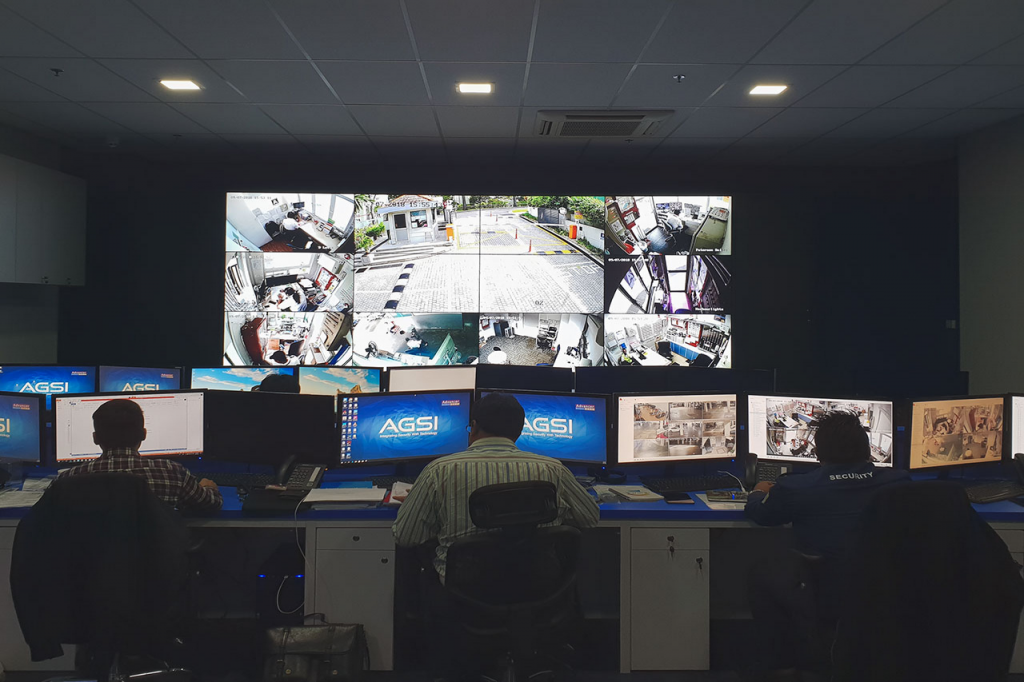Top image by Marisse Caine.
This is the second in a two-part series about the PWM and the security sector. Read the first part here.
As the year creeps to a close, the Progressive Wage Model (PWM)-vs-minimum wage debate continues to rage on, by turns confusing, dense, politically charged, and largely lacking in voices from the ground.
Last month, I interviewed five security guards about how the PWM had worked for them. While none dismissed the policy outright, most felt its promises of better pay and prospects hadn’t quite materialised. Although their pay had risen, it remained significantly below the median, even for the most senior officers. Those supporting families were clearly struggling.
Meanwhile, the payoff from skills-training was unclear, and pointed to the need for an industry overhaul—challenges which neither the PWM nor a minimum wage are meant to tackle.
The next step, naturally, was to get employers’ take on this. For that, I reached out to Raj Joshua Thomas, President of the Security Association Singapore, and asked: what has the PWM done for the industry? And where do you stand on this debate?
Spoiler alert: Joshua was Team PWM, but not for the reasons I expected. In fact, he spent most of our chat highlighting multiple ways in which the PWM had not fully delivered so far. He nonetheless argued that it is the better policy tool, compared to a minimum wage —because of all its untapped potential.
Below is a summary of his explanation.

1. First, a little context.
The industry has 252 licensed security agencies employing around 48,000 full-time officers. This is far below what it needs: echoing the security guards I spoke to, Joshua confirmed that the industry has been facing a labour shortage. Moreover, around 50% of officers are over 55, exacerbating concerns about how the sector will cope as officers age out of work.
Notably, all three of the current PWM industries—namely security, cleaning, and landscaping—are outsourced sectors. Workers are technically employed by agencies, but their day-to-day work is directed by buyers (such as MCSTs and large corporations), who contract the agencies to provide manpower.
For this reason, Joshua suggested that it’s not enough to focus on agencies, who are merely intermediaries in the supply chain. Rather, in outsourced sectors, it’s buyers who function like the ultimate employers—an aspect of the equation that’s been neglected so far. But we’ll get to that in a bit.
2. Pre-PWM, agencies were doing well—largely because workers were so badly paid.
Before the PWM took effect in 2016, security guards used to earn even less than they do now.
“8 to 10 years ago, an officer used to be paid around $1,300 per month, including overtime. The take-home wage was just above $1, 000.” said Joshua, not bothering to mince his words. “It’s ridiculous. Before the PWM, agencies’ margins were very high. Hay was being made.” (Basic pay (not including overtime) for a Level 1 officer is now $1,250.)
Moreover, some agencies then would engage in shady or illegal practices to avoid complying with their wage obligations, such as paying CPF.
3. Even after the PWM, security officers remain chronically underpaid.
“There was definitely a jump in wages [after the PWM], but let’s put the numbers in context,” said Joshua.
“A Level 1 officer today, paid at the minimum level, will take home around $1,750 after deducting the employee’s CPF (but not including allowances). These guys are working 12 hours a day, six days a week. This situation simply cannot be correct.”
For context, according to MOM data, the current median wage for Singaporeans after CPF is S$4,000. Using Joshua’s figure of S$1,750 as a ballpark, a Level 1 officer brings home around 55% under the average.
The SAS plotted officers’ basic pay against the median wage all the way through to 2030, and found that even with the PWM increments, the former would always trail the latter by around 50%, if not more. Moreover, the pay disparity applies regardless of seniority: even the highest-ranked Level 4 officer will always be earning significantly under Singapore’s median wage.
“There should be no question that security officers are still severely underpaid. And there should be no question that we need to move much faster to raise their wages in the next 10 years,” he added.

4. But agencies are no longer raking in profits. With costs increasing due to the PWM, they’ve resorted to undercutting each other …
Post-PWM, agencies’ profits dropped significantly, but they were able to absorb this at first because margins were already high. The plan was to absorb the increase in costs for the first couple of years, and then slowly begin passing these off to buyers.
But according to Joshua, this hasn’t happened. Instead, contract prices have begun to come down.
If you’ve been following so far, this shouldn’t seem right: low supply and high demand ought to make it a sellers’ market. But it isn’t—in part because there are too many agencies.
“The industry may be oversaturated,” said Joshua.
This prevents agencies from reaping economies of scale. “252 agencies means 252 command centres, operations staff, finance teams, all the resources it takes to run a company. It’s really inefficient for a small country like Singapore,” he added.
The SAS is concerned that the texture of the industry, in its current form, is no longer sustainable: agencies will have to either merge or overhaul their business models to survive, or be forced to close. According to Joshua, while the SAS has held outreach sessions to advise members on how to deal with these headwinds, take-up has been low.
5. … and some have turned to breaking the rules.
As a result of lowballing, agencies sometimes bid below the minimum they would need to charge to pay workers at PWM rates. And if they can afford to charge prices that low, it might be because they’re flouting the rules.
He tells me that the SAS has received anecdotal, but reliable, reports of a few agencies committing regulatory infractions—failing to pay officers the prescribed PWM rates, breaking the overtime regulations, and so on. These errant agencies are hurting the industry and its reputation, and driving prices down.
“Of course, most agencies are doing the right thing, but they end up losing contracts, so they are disincentivised to be good players,” said Joshua. “Agencies are ailing, and they’re finding ways and means of staying afloat. And unfortunately, some of them turn to breaking the rules.”

6. Meanwhile, no one has figured out how to get buyers to pay more.
However, oversaturation in the industry is just half of it. The bigger problem, according to Joshua, is that buyers’ prices haven’t risen with costs.
“Ministers have been saying that buyers have to pay more, but ultimately it’s a matter of private contract,” he said. “At the supply level, our costs are increasing because of the PWM increases, but the demand side is left up to market forces. And because there are so many agencies, buyers can always find another one willing to bid lower.”
“Buyers’ prices have not kept pace with costs, let alone to an extent where the industry can contemplate faster or higher wage increases. It’s this disconnect that’s causing the turmoil right now.”
“Even though we are an essential service and play an important role, buyers are generally not prepared to pay at fair rates that would enable agencies to pay their officers fair wages.”
7. The PWM could offer a way to address this.
Joshua is pro-PWM for several reasons, including its sector-specificity and flexibility in setting wage levels (relative to a minimum wage). Most significantly, he sees it as a way for outsourced sectors like security to solve the buyer issue: by using the PWM to affect prices.
He outlines a couple of ideas. One would be to implement a minimum threshold for agencies to bid for contracts, based on the PWM rates. This could be pegged to a disclosure regime: if an agency bids below the minimum amount it would have to charge to break even and fulfil its regulatory obligations, including the PWM, it would have to disclose this and open itself to being audited. This would help weed out errant agencies.
“Of course buyers don’t want to pay higher, and agencies want to stay afloat, so they bid lower to get contracts. That’s the problem we have right now,” said Joshua.
“It’s a matter of the horse and the cart. If you think of wages as the cart, and prices or buyers as the horse, we keep loading the cart with no horse to pull it.”
This links back to his argument that buyers of outsourced services are not pure buyers per se, but operate more like pseudo-buyers or ultimate employers. “That’s why the PWM should look at how to affect prices systematically. It is clear that we can’t simply leave prices to market forces”.
Conversely, he argues, a minimum wage would not be able to exert the same kind of influence on prices.
“I think the PWM could take prices into consideration, and that’s why it’s superior to a minimum wage. But we haven’t explored its full potential yet.”

8. Side note: the productivity-and-upskilling aspects of the PWM should not be oversold.
So far, the PWM has been described as a “minimum wage plus” on the basis that it increases productivity along with wages. In practice, however, Josh described the policy as an ‘exercise in aspiration’, confirming what the security guards had told me: that real skills development, or career advancement, is limited.
“In theory, the PWM provides advancement, but if you look at what officers are doing on the ground at the moment, the differentiation is quite minimal. There is very little difference between a Level 1 officers’ job scope and a Level 2 officer, and even between Level 2 officers and Level 3 supervisor. Many of them also carry out junior-level tasks,” said Joshua.
He admitted that security agencies needed to do better in this. “We haven’t provided that sense of getting somewhere, of recognising seniority, and I think that’s a failure of imagination on our part.”
Investing in technology would dramatically change both the industry and security officers’ job scope, but he contended that buyers have a role to play in this. This links back to his point that buyers in outsourced sectors really function more like employers, given how they dictate security officers’ daily responsibilities.
The services they contract agencies to provide determine what officers end up doing on the ground. And if they never engage agencies for more than the most basic security functions, there will be little incentive for agencies to invest in technology—or for officers themselves to upskill.

9. It’s too simplistic to see the PWM as solely an issue of wages. Similarly, looking at wages in isolation won’t get us anywhere.
To recap: the industry is overcrowded, leading to incidents of undercutting and regulatory infractions. Even if agencies consolidate and shrink the pool of sellers, to raise officers’ pay both fast enough and significantly enough, a more sustainable way to share cost increases with buyers will have to be found. And unless buyers recognise a greater need for technology, there will be no incentive for agencies to invest in this—or for officers to upskill and enjoy real career advancement.
Still, I asked Joshua why he continues to retain so much faith in the PWM, especially when it’s been heavily criticised for taking too long to do too little. After all, eight years have gone by, only three sectors are covered, and—as he’s strenuously argued—workers are still underpaid.
His answer? Yes, PWM has taken a long time, yes, it could do better on several fronts. But rather than attributing this to clunky bureaucratic machinery, he suggested that stakeholders simply haven’t been bold or imaginative enough in exploring all the PWM could do.
To him, it’s in agencies’ interests to support better wages for security officers, since higher salaries would help the industry attract more workers (and because they simply need to be paid better). But unless a plan is developed for tackling prices as well, instead of looking at wages in isolation, it would be pointless to expect security agencies to argue for anything other than baby steps.
“I don’t have the hubris to believe that I have all the answers, but we have to start somewhere. We can and need to move much faster on wages. But to achieve this, we have to talk about prices. And at least for outsourced sectors, the PWM could affect this.”
At this point, it should be clear that the PWM can’t be viewed through the lens of any single issue.
The urgent need for workers to be paid reasonable, livable wages, considered against the broader backdrop of poverty and inequality, is one of these. At the same time, there are many other moving parts to the discussion: the role of consumers and buyers, the sustainability of individual industries, and the role of government intervention in markets.
Ideological devotion to solutions—whether the PWM, a minimum wage, or any other policy tool—should not prejudice us against considering these, and the discussion needs to remain open and nonpartisan. Only then might we see real progress.







